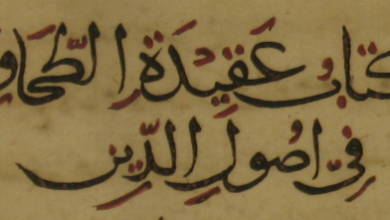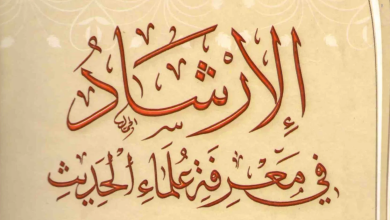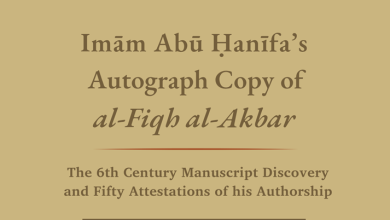Ibn Bāz (d. 1999), Sulaymān ibn Siḥmān (d. 1930) & al-Fawzan on the Term “Wahhābī” as an Ascription to the Way of Muḥammad ibn ʿAbd al-Wahhāb (d. 1792)
The designation “Wahhābī” represents a complex historical and theological marker within Islamic intellectual discourse, primarily referring to adherents of Muḥammad ibn ʿAbd al-Wahhāb al-Najdī’s (d. 1206/1792) reformist movement. This theological current emerged in the eighteenth-century CE in the Najd region of central Arabia, characterized by its emphasis on theological purification and return to what it considered pristine Islamic practices.
A significant tension exists between contemporary reception and historical usage of the term. Modern Salafī scholars and adherents generally reject the designation “Wahhābī,” considering it a reductive or pejorative label that fails to capture the movement’s self-understanding as a return to authentic Islamic practice rather than a novel sectarian formation. However, this contemporary position presents an interesting historiographical puzzle when contrasted with historical evidence of the term’s usage by figures within the movement itself.
This complexity is particularly evident in the case of Sulaymān ibn Siḥmān (or some read it as Sahmān, d. 1349/1930), a prominent theological writer and defender of Ibn ʿAbd al-Wahhāb’s doctrinal positions. Ibn Siḥmān’s deliberate incorporation of the term “Wahhābiyya” in the titles of his apologetic treatises suggests a more nuanced historical relationship with the designation than contemporary rejection might indicate. This historical usage by an authoritative figure within the movement raises important questions about the evolution of self-identification practices and the changing dynamics of religious nomenclature in Islamic theological discourse.
Further insight into this terminological debate comes from the late Saudi Grand Mufti ʿAbd al-ʿAzīz ibn Bāz, whose views on the acceptability of the term “Wahhābī” provide crucial perspective from one of the movement’s most authoritative modern voices. Ibn Bāz’s position on this nomenclature offers valuable context for understanding how the movement’s leadership has historically engaged with questions of identity and external categorization.
The discrepancy between historical acceptance and contemporary rejection of the term “Wahhābī” warrants careful analysis within the broader context of Islamic reformist movements’ complex relationships with externally applied designations and the ongoing negotiation between self-identification and imposed categorization in religious studies.
Here are two examples of treatises authored by Sulaymān ibn Siḥmān that explicitly incorporate the term “Wahhābiyya” in their titles:
A) Al-Hadiyya al-Saniyya wa-l-Tuḥfa al-Wahhābiyya al-Najdiyya (الهَدِيَّة السَّنِيَّة وَالتُّحْفَة الوَهّابِيَّة النَّجْدِيَّة) [The Splendid Gift and the Wahhābī Najdī Present] was published as a 2nd edition in Egypt in 1344 AH/1926 CE, with the assistance of another Wahhābī/Salafi writer known as Rashīd Riḍā, and the front cover mentioned that it was printed by order of King ʿAbd al-ʿAzīz Āl Saʿūd. Title page:

On p. 2 of this work he mentioned the following points:
فلما تصدر وانتصب هذا الرجل المسمى بعبد القادر الاسكندراني العداوة أهل الإسلام أتباع المئة الحنيفية، والطريقة المحمدية وشرق بهذا الدين، الذي من الله به على اخواننا الدمشقيين، لما تبين لهم حقيقة ما عليه أهل الاسلام الموحدين من أهل نجد المشهور بن بالوهابية، وأنهم كانوا على ما كان عليه سلف هذه الامة وأئمتها من اخلاص العبادة الله رب العالمين، وترك عبادة ما سواه مما كان عليه أهل الكفر والشرك برب العالمين، وانكار البدع المحدثة في الدين، وكتب ردا على الوهابية، المتمسكين بالطريقة المحمدية والملة الحنيفية ، ورماهم بما هم بريتون منه من هذه الاكاذيب والاوضاع ، التي تمجها الطباع، وتستك عند سماعها الاسماع، وسماها (النفحة الزكية في الرد على شبه الفرقة الوهابية)
Meaning:
“When this man named ʿAbd al-Qādir al-Iskandarānī came forward and positioned himself in enmity towards the people of Islam who follow the pure monotheistic religion [al-Ḥanīfiyya] and the Muḥammadan way, he became choked with this religion, which Allah had bestowed upon our Damascene brothers, when the truth became clear to them about the state of the monotheistic people of Islam from the people of Najd known as the Wahhābīs, and that they were following what the predecessors of this nation and its leaders had followed in terms of sincere worship to Allah, Lord of the Worlds, and abandoning the worship of anything other than Him which was the practice of the people of disbelief and polytheism, and rejecting religious innovations [bidaʿ]. He wrote a refutation against the Wahhābīs, who adhere to the Muḥammadan way and the pure monotheistic religion [al-milla al-Ḥanīfiyya], and accused them of things they are innocent of, consisting of lies and fabrications that nature rejects and from which ears recoil upon hearing. He named it “The Pure Fragrance in Refuting the Doubts of the Wahhābī Sect” [al-Nafḥa al-Zakiyya fī al-Radd ʿalā Shubah al-Firqa al-Wahhābiyya].”
The text, written by Sulaymān ibn Siḥmān, provides evidence that both supporters and opponents of Muḥammad ibn ʿAbd al-Wahhāb’s movement used the term “Wahhābī” [al-Wahhābiyya] as a descriptive label in their discourse. This is demonstrated where he mentions “the people of Najd known as the Wahhābīs” [ahl Najd al-mashhūrīn bil-Wahhābiyya] when describing the movement’s followers, while also referencing how their opponent ʿAbd al-Qādir al-Iskandarānī used the same term in his polemical work’s title “The Pure Fragrance in Refuting the Doubts of the Wahhābī Sect” [al-Nafḥa al-Zakiyya fī al-Radd ʿalā Shubah al-Firqa al-Wahhābiyya]. This indicates the term was in common usage by both sides during this period.
B) Al-Mawāhib al-Rabbāniyya fī al-Intiṣār lil-Ṭāʾifa al-Muḥammadiyya al-Wahhābiyya wa-Radd Aḍālīl al-Shubah al-Daḥlāniyya (المَواهِب الرَّبّانِيَّة في الانْتِصار لِلطّائِفَة المُحَمَّدِيَّة الوَهّابِيَّة وَرَدّ أَضاليل الشُّبَه الدَحْلانِيَّة) [The Divine Gifts in Support of the Muḥammadan Wahhābī Sect and in Refutation of the Erroneous Specious Arguments of Daḥlān], which he completed in 1302/1884. The manuscript is held in the King Saud manuscript collection in Saudi Arabia (see it uploaded here – https://archive.org/details/1713Pdf_201812/page/n1/mode/2up).
Title page:

The verdict of the late Saudi grand Muftī ʿAbd al-ʿAzīz ibn Bāz (d. 1999 CE) on the title Wahhābī
The late ʿAbd al-ʿAzīz ibn Bāz viewed the designation “Wahhābī” as an honorific title for the adherents of the religious call [daʿwa] of Muḥammad ibn ʿAbd al-Wahhāb al-Najdī, rather than as a pejorative term as some of its adherents have contended. For ibn Bāz, this appellation signified association with the movement’s commitment to Islamic monotheism [tawḥīd] and its opposition to what it deemed as polytheistic practices [shirk], such as the veneration of graves and excessive devotion to righteous figures. This interpretation stands in contrast to the position of some followers who reject the term, viewing it as an externally imposed label meant to delegitimize the movement by reducing it to a separate sect rather than what they consider a return to authentic Islamic practices.
In the following link one may listen to the verdict of Ibn Bāz on the title in question:
Some quotes:
السؤال: له سؤال ثالث وأخير يقول فيه: يسمي بعض الناس عندنا العلماء في المملكة العربية السعودية بالوهابية، فهل ترضون بهذه التسمية؟ وما هو الرد على من يسميكم بهذا الاسم؟
Meaning:
The question: He has a third and final question in which he says: Some people among us call the scholars in the Kingdom of Saudi Arabia “Wahhābīs,” so are you content with this naming [tasmiya]? And what is the response to those who call you by this name?
الجواب: نعم هذا لقب مشهور هذا اللقب مشهور لعلماء التوحيد لعلماء نجد، ينسبونهم إلى الشيخ الإمام محمد بن عبد الوهاب رحمة الله عليه؛ لأنه دعا إلى الله في النصف الثاني من القرن الثاني عشر واجتهد في إيضاح التوحيد وبيان الشرك للناس، حتى هدى الله به الجم الغفير، ودخل الناس في توحيد الله وتركوا ما هم عليه من أنواع الشرك الأكبر، من عبادة أهل القبور ومن البناء على القبور وعبادة الأشجار والأحجار والغلو في الصالحين، فصارت دعوته دعوة تجديدية إسلامية عظيمة نفع الله بها المسلمين في الجزيرة العربية وفي غيرها، رحمه الله رحمة واسعة، وصار أتباعه ومن دعا بدعوته ونشأ على هذه الدعوة في نجد يسمى بالوهابي، وكان هذا اللقب علماً على أهل التوحيد، كل من دعا إلى توحيد الله ونهى عن الشرك وعن التعلق بالقبور أو التعلق بالأشجار والأحجار وأمر بالإخلاص لله سموه وهابياً، فهو لقب شريف عظيم يدل على أن من لقب به من أهل التوحيد ومن أهل الإخلاص لله، وممن ينهى عن الشرك بالله وعن عبادة القبور والأشجار والأحجار والأصنام والأوثان. هذا هو أصل هذه التسمية وهذا اللقب
.
Meaning:
“The answer: Yes, this is a famous title [laqab mashūr], this title is well-known for the scholars of monotheism [ʿulamāʾ al-tawḥīd], for the scholars of Najd, who are attributed to al-Shaykh al-Imām Muḥammad ibn ʿAbd al-Wahhāb, may Allah have mercy on him; because he called to Allah in the second half of the twelfth century and strove in clarifying monotheism [tawḥīd] and explaining polytheism [shirk] to people, until Allah guided through him numerous people, and people entered into the monotheism [tawḥīd] of Allah and abandoned what they were upon of types of major polytheism [al-shirk al-akbar], from worshipping the people of graves and from building upon graves and worshipping trees and stones and exaggeration [ghuluw] regarding the righteous. Thus, his call [daʿwa] became a great Islamic revivalist call through which Allah benefited Muslims in the Arabian Peninsula and elsewhere, may Allah have vast mercy upon him. His followers and those who called with his call and grew up upon this call in Najd came to be called Wahhābī, and this title became a mark for the people of monotheism [ahl al-tawḥīd] – everyone who called to the monotheism of Allah and forbade polytheism and attachment to graves or attachment to trees and stones and commanded sincerity to Allah, they called him Wahhābī. So, it is a noble, great title [laqab sharīf ʿaẓīm] indicating that whoever is titled with it is from the people of monotheism [ahl al-tawḥīd] and from the people of sincerity to Allah, and from those who forbid polytheism with Allah and the worship of graves, trees, stones, idols and false deities. This is the origin of this naming [tasmiya] and this title [laqab].”
He also said:
فهو لقب معروف شريف وليس بالمستنكر بل هو لقب لأهل التوحيد والإيمان، لأهل الدعوة إلى الله عز وجل وهكذا انتشر هذا اللقب
“So, it is a well-known, noble title [laqab maʿrūf sharīf] and not something to be denounced [mustankar], rather it is a title for the people of monotheism and faith [ahl al-tawḥīd wa-l-īmān], for the people who call [ahl al-daʿwa] to Allah, the Mighty and Majestic, and thus this title spread.”
The verdict of a contemporary Saudi writer known as Salih al-Fawzan:
(source: https://abdurrahman.org/2012/02/14/then-yes-i-am-a-wahhabi-sheikh-al-fawzan/ and original audio – https://youtu.be/ErZd7y3xh30?si=vCjF-iWghls_N8vN):
Quotes:
Question:
Why are all of those who call towards Tawhîd called as “Wahhâbiyyah” ever since Shaykh Muhammad bin ‘Abdil-Wahhâb (rahimahullâh)? This word scares off many people from those who call towards Tawhîd.
Shaykh al-Fawzân:
No, it doesn’t scare off at all. We are proud of the fact that the one who calls towards Tawhîd is called as “Wahhâbî” and all praise is due to Allâh. What is the one who calls towards Shirk (idolatry, polytheism) called then? What is he called? Jâhilî!
We are proud of it. Let them then say “Wahhâbî”. They are thusly themselves witnessing that the call of Wahhâbiyyah is a call towards Tawhîd. The author of “al-Lanjah” (rahimahullâh) said:
“If the one who follows Ahmad is a Wahhâbî, then let the humans and Jinns witness that I am a Wahhâbî.”
Ahmad here is the messenger (sallâ Allâhu ‘alayhi wa sallam);
“If the one who follows Ahmad is a Wahhâbî, then let the humans and Jinns witness that I am a Wahhâbî.”
Some critics have raised a grammatical objection to the designation “Wahhābī” for the movement of Muḥammad ibn ʿAbd al-Wahhāb, suggesting it should instead be termed “Muḥammadī” if derived from the founder’s name. However, this argument overlooks some established precedents in Islamic scholarly nomenclature. Two notable examples demonstrate the validity of deriving school names from the patronymic (nasab) rather than the given name (ism):
1) Muḥammad ibn Idrīs al-Shāfiʿī: His legal school [madhhab] is known as Shāfiʿī (derived from his patronymic) rather than Muḥammadī
2) Aḥmad ibn Ḥanbal: His legal school is termed Ḥanbalī (derived from his patronymic) rather than Aḥmadī
Thus, the designation “Wahhābī,” derived from the patronymic “ʿAbd al-Wahhāb,” follows established patterns of Islamic scholarly nomenclature, making it grammatically sound and historically consistent with traditional naming conventions for Islamic intellectual movements.
Peace and blessings be upon our Prophet Muḥammad
Compiled by: Abul Hasan Hussain Ahmed, darultahqiq.com
17th of February 2025/18th of Shaʿbān 1446 AH
Download the article as a PDF file – HERE






